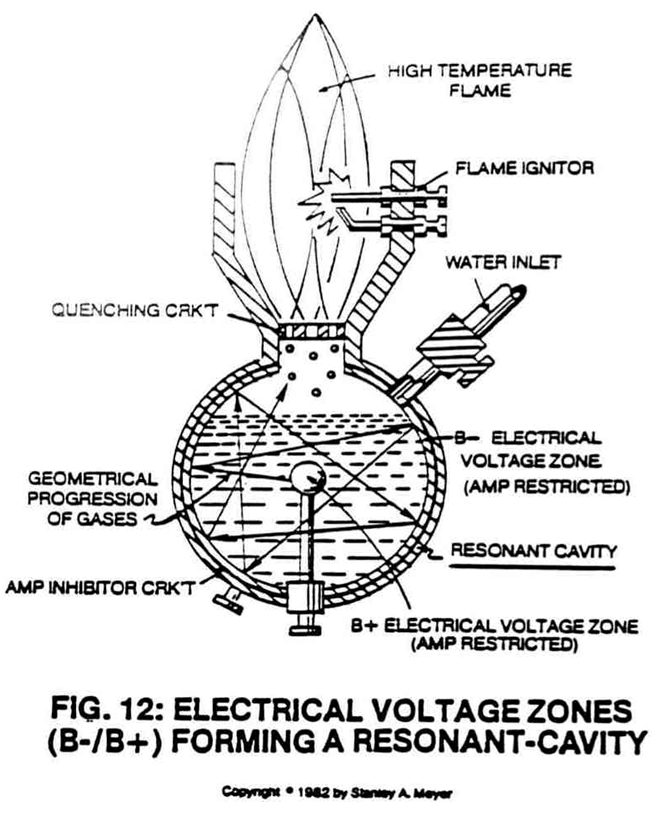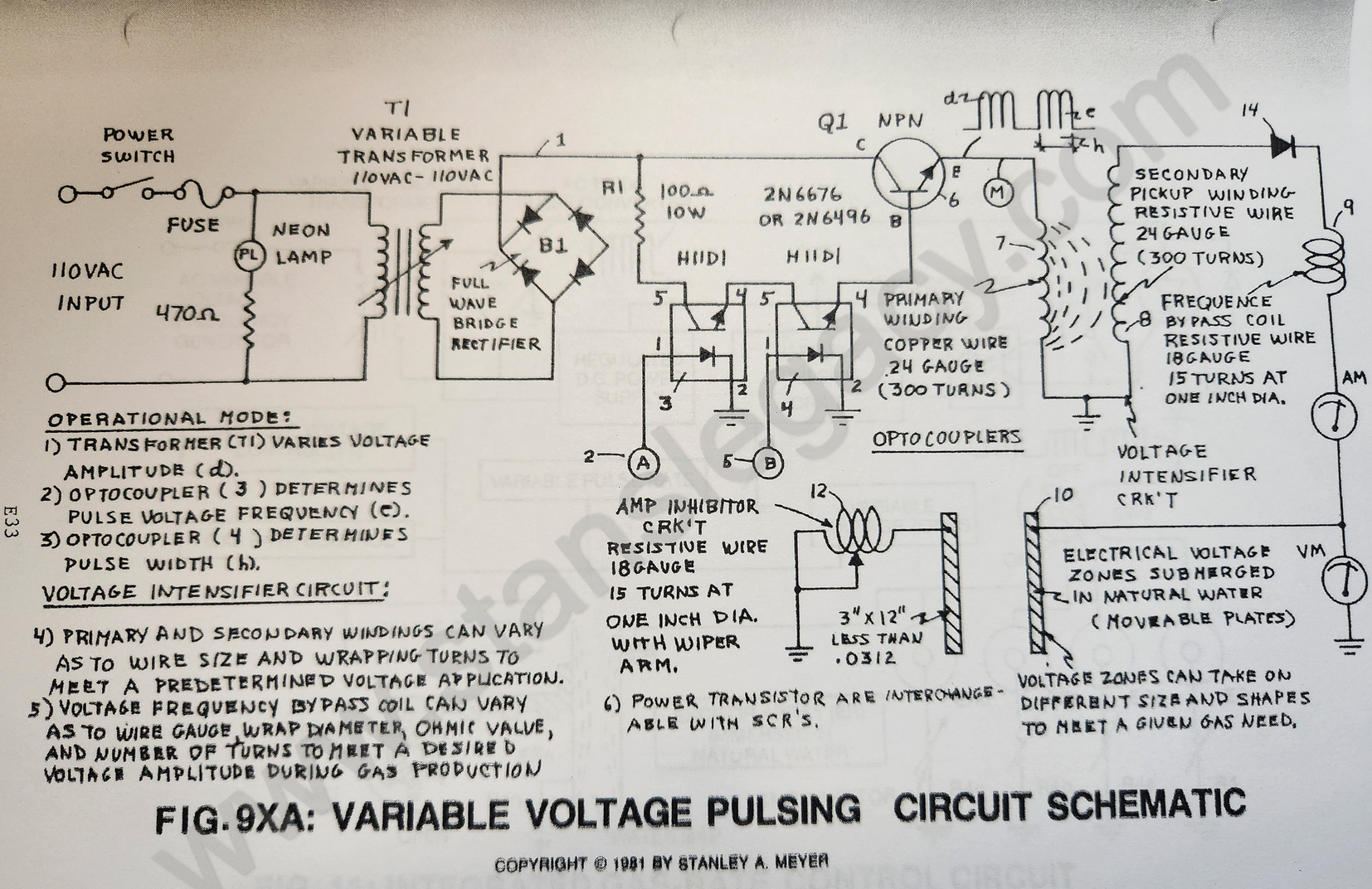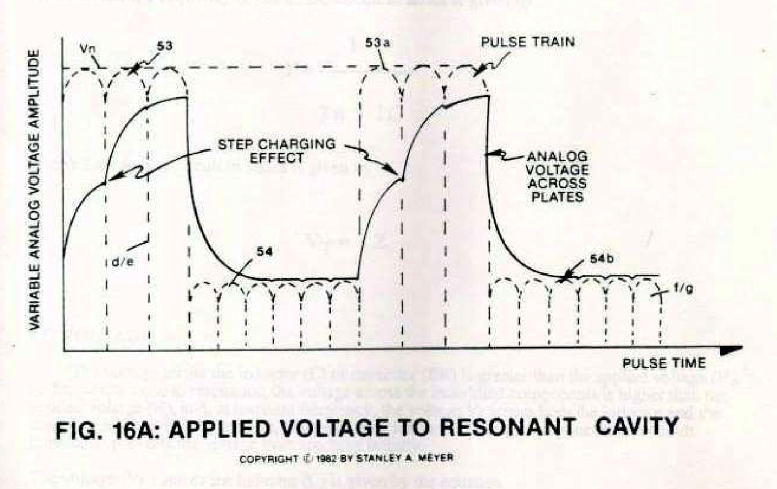SINGLE VOLTAGE RESONANT "Q"
Electron Flow VS Voltage Amplitude VS Voltage Frequency:
In reference to Voltage Intensifier Circuit 9XA as to dual-voltage schematic 20YA and pulse voltage wave form 9BB/16A/20YA Section AA, the following operational parameters exist:
Electronic Interfacing Circuit:
Secondary Pickup Winding (resistive wire coil) (42), Blocking Diode (14), Resonant Charging Choke (resistive wire coil) (43), Resonant Cavity Inner Surface (45) (forming a Positive Electrical Voltage Zone), Resonant Cavity Outer Surface (44) (forming a Negative Voltage Zone).
Voltage zone surface area (44/45) form the capacitance value of said Resonant Cavity Assembly of Figure 12.
Natural water inside said Resonant Cavity Assembly (44/45) provides the dielectric value between said voltage zones (44/45), resonant charging choke (47) to electrical ground forms and completes the Voltage Intensifier Circuit 9XA as to 20YA.
 |
 |
Circuit Operational Parameters:
Purpose: To form opposite Electrical Voltage Zones while restricting amp flow during the Electrical Polarization Process (splitting the water molecule by way of Voltage stimulation).
Component Interaction:
Secondary Pickup Winding (42): The resistive wire-coil (42) allows a voltage potential (electromagnetic induction process) to form across said pickup-coil (42) while the resistive value (Ohm value) of said coil-wire acts as a resistor which opposes electron flow from said circuit electrical ground (48).
Scientific Fact: Since electrons are Negative Electrically Charged, electron flow (amp flow) always moves toward positive electrical potential... if allowed.
Block Diode (14): Since Blocking Diode (14) conducts electricity in one direction "ONLY" (direction of schematic arrow), electron flow or movement toward said pickup coil (42) is prevented during said Positive Voltage Potential formation.
 Resonant Charging Choke (43): Said Resonant Charging Choke (43) is a Modulator Inductor which sets up an oscillation of a given charging frequency (voltage pulsing rate) with the effective capacitance of a pulse-forming network in order to charge a line to a high voltage. See Modern Dictionary of Electronics 6th Edition by Rudolf F. Graf. The resistive value of said Charging Choke (43) acts as a resistor... preventing amp flow still further.
Resonant Charging Choke (43): Said Resonant Charging Choke (43) is a Modulator Inductor which sets up an oscillation of a given charging frequency (voltage pulsing rate) with the effective capacitance of a pulse-forming network in order to charge a line to a high voltage. See Modern Dictionary of Electronics 6th Edition by Rudolf F. Graf. The resistive value of said Charging Choke (43) acts as a resistor... preventing amp flow still further.
Electrical Voltage Zones (44/45): Said High Voltage Output from said Resonant Charging Choke (43) forms a Positive Electrical Voltage Pulse Potential (voltage zone) across said voltage surface area (45) immersed in natural water, see step-charging graph 16A as to 20YA Section AA again.
Scientific Fact: Stainless Steel Material T304 forming said voltage zone (45) does "NOT" chemically interact with liberated hydrogen, oxygen, and ambient air gases in natural water when exposed to a voltage potential during amp restrictions.
Capacitance: Capacitance value is formed between said conductor plates 44/45 (conducting medium between two plates) of natural water is relatively high.
Capacitance opposes any change in circuit voltage.
A voltage change is delayed until the stored charges can be altered through current flow... if allowed.
Component arrangement of said Voltage Intensifier Circuit 9XA as to 20YA retards or prevents amp flow.
Scientific Fact: Distilled water is an insulator to the flow of amps; natural water has less than 20ppm of any type of contaminates and maintains a high dielectric constant.
Amp Inhibitor Component (47): Another Resonant Charging Choke (47) is placed between said negative voltage zone (44) and said circuit electrical ground (48) to help maintain capacitance value (voltage level) within the Resonant Cavity during voltage pulsing.
The resistive value of said wire-coil (47) acts as a resistor while performing in like manner as a Resonant Charging Choke (43).
 |
